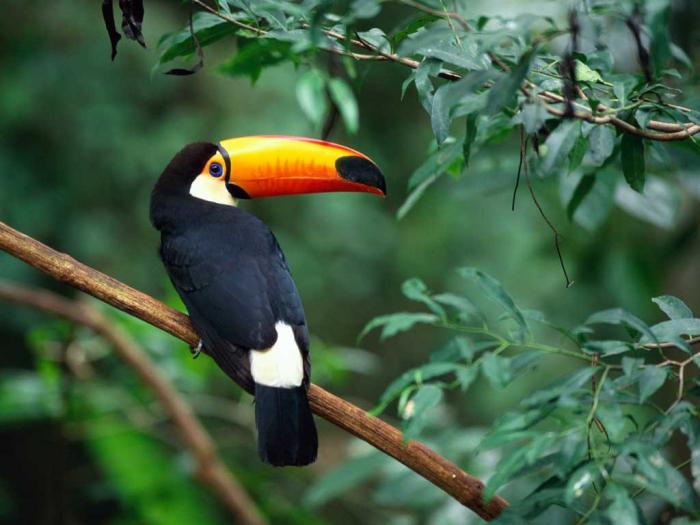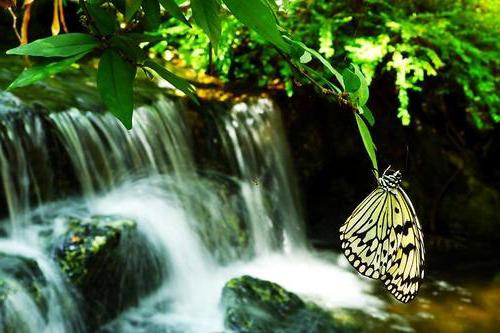The Arctic is one of the coldest and most lifeless regions on Earth. Includes part of Eurasia. The geographic location of the Arctic belt is limited to the North Pole and the Arctic Ocean. There are common borders with the American continent. Often, the northern regions of the Pacific are referred to the water area of the belt, and the total Arctic occupies more than 27 million square kilometers.
Winter in Midwest Brazil has low temperatures caused by the invasion of polar winds at this time of the year. The average low temperature ranges from 8 to 18 degrees Celsius, and the minimum temperature usually drops to negative values. Despite the presence of three different systems that affect its climatic structure, the region of the Midwest is well supplied with rainfall. Its seasonality is usually tropical, with maximum rainfall in summer and minimum rainfall in winter. More than 70 percent of the total rainfall in the Midwest occurs between November and March.
Climatic zone
The meteorological indicators of this area are due to the cold northern Arctic climatic zone dominates the entire water area of the Arctic Ocean, as well as on the outskirts of Siberia. Frosty weather in these parts of the Earth lasts all year round. Permafrost not warmed up by the sun's rays, as they fall on the ground tangentially.
The winter months, June to September, are very dry because rain is extremely sparse. The Iberian Peninsula presents big variety climates due to its geographic location and its orography. It is located in the southern limit of the influence of the polar front, which, with associated storms, is responsible for the wet continental climate western zone of Europe. On the other hand, it is also on the northern border of the high pressure areas of the tropics, which, due to their dry and warm air, generate large desert areas of the Sahara.
Typically, the northern peninsula will be more affected by the cyclical system of storms, while the south will be dominated by more tropical climate... Due to atmospheric dynamics, it is common for wet Atlantic fronts to cross the peninsula in winter, causing heavy rainfall. It can be said that the climate of the peninsula has only two main seasons - summer and winter, since spring and autumn are the seasons of transition, in which, as a rule, intermediate situations of summer or winter alternate. However, this ideal situation often changes due to the dynamic nature of the atmosphere.
We can say that the cold in the Arctic is constant. Even in summer time solar radiation unable to penetrate thick ice layers. The surface still receives a small amount of heat, but it goes to melting the snow cover. The Arctic climate zone is always characterized by subzero temperatures, and precipitation in this area is extremely rare. The reason is the minimal accumulation of water vapor due to the constantly low temperatures. Average level precipitation does not exceed 200 mm per year.
Thus, the waviness of the polar front can be more pronounced, which leads to a change in the general picture and an expansion of the conditions of continental humidity on the peninsula. Likewise, these undulations may be weaker, so that anticyclones become more relevant and extend a warmer, drier climate.
Peninsular topography will also determine the types of climates present. The peninsula is a steep relief with numerous mountain systems, which are concentrated mainly on the periphery, closing it to sea impact, with the exception of the western zone. When Atlantic rain fronts penetrate the peninsula, they travel, unloading water, until they collide with one of the mountain systems will not be able to overcome them and create precipitation areas where precipitation is lower than in nearby areas.
Closer to the European part of the continent, it predominates. The main zone of its distribution is considered Eastern Siberia... Here the climate is less severe, suitable for life. Temperatures often rise to +12 degrees. Annual quantity precipitation is twice as much - up to 450 mm.
Each climatic zone of the earth differs from others in unique characteristics. Even such intermediate options as subarctic or subtropical have their own characteristics. They can define vegetable world or the conditions of farming. What exactly distinguishes the subtropical belt? Let's try to figure it out.
This situation is responsible for the emergence of dry areas in the southeastern part of the peninsula, as well as in other regions. In other cases, the orography of an area has the opposite effect, when in a zone in favor of the wind, the mountains collect all the rain that the fronts carry, increasing precipitation in certain zones.
As a first approximation, using the classification of the world's climate based on the movement of air masses, the Iberian Peninsula is divided into three large areas... The first covers almost the entire territory, with a semi-arid Mediterranean climate, that is, a steppe, with a southeastern southeastern zone, between the steppe and the desert. The second zone occupies a narrow coastal strip, which begins between the mouths of the Tahoe and Duero rivers, rises to the north and crosses the entire Cantabrian cornice. The third is an area of lesser extent than the previous one, which begins in the western part of the Cantabrian mountains and ends in the eastern part of the Pyrenees.
Where is he located?
The subtropical climatic zone lies in two hemispheres. It is located between the equator and the tropics. Due to the extremely favorable conditions for human survival, which the subtropical belt creates, it was on such a territory that the first ancient civilizations appeared. And Mesopotamia, and Palestine, and Greece are located in this strip. In addition, now these are the most best areas for tourism and agriculture: olives, grapes, citrus fruits and many other species grow here. 
This will be the climate of areas at high altitudes. The Cantabrian cornice, along with other areas of Castile-León and Aragonese, represented a moderate and humid climate with a mild summer. Within this framework, two areas will be highlighted. However, these two approaches are insufficient to describe, albeit broadly, the climate diversity of the peninsula. The description of the peninsular climate is not exempt from some polymers, but there seems to be some agreement on the delineation of the three main climatic zones: Atlantic, Continental and Mediterranean.
These areas are heterogeneous, but differ from each other due to their geographic situation and the influence of relief. First, the Atlantic region occupies peninsular regions in close contact with Atlantic Ocean from which they gain great influence by softening their temperature and directly influenced by the fronts that come from the sea, which gives them a more humid climate. This zone covers the peninsular north, from the eastern end of the Pyrenees to Galicia, in the west, occupying the western outskirts of Portugal and most of the coastal regions of Andalusia to the eastern part of the province of Granada.
Main characteristics
Subtropical belt characterized by low precipitation in summer - such conditions create high pressure areas and cyclones with frequent rains in winter. The temperature in the warmest month averages twenty-five degrees, and in the coldest - five. Summer is characterized by dry and hot weather with a minimum of clouds, while winters are quite windy and rainy. Such conditions provide a small amount of snow that does not linger for long. If the territory of the subtropical zone covers the highlands, the so-called cold desert climate occurs. It is distinguished by extremely cold winters with temperatures down to minus fifty and cool summers, unstable snows and strong winds. V eastern regions the belt is dominated by the monsoon variant. It is characterized by warmer and cloudy summers. Winter is getting drier. The subtropical belt, in which precipitation is usually scarce, here is characterized by an amount reaching almost a thousand millimeters. Because of this, lush vegetation grows in this area and agriculture develops well.
The peninsular north and good parts of Portugal's coastal strip are affected by continuous storm fronts that cross mid-latitudes, defining a humid climate with rainfall throughout most of the year and moderate temperatures in both summer and winter.The following table summarizes these climatic conditions.
Another area of influence of the Atlantic lies within Portugal, where the influence of the ocean is still strong. However, as the interior penetrates, the continental climate intensifies, making it more extreme, with reduced precipitation and increased average temperatures.

Territories
Where does this weather occur? The subtropical climatic zone covers a large territory of Turkmenistan, the state of Rajasthan in India, Afghanistan in the flat part, the pampas Iranian Highlands, Bukhara, the Xinjiang Basin, the Great Basin of South Australia.
Characteristic plants
The subtropical belt, whose precipitation is seasonal, is well suited for some species of flora. All vegetation can be subdivided into several types - hemigileia, monsoon, hard-leaved or Mediterranean forests. Each of them is accompanied by certain types of plants. Stiff-leaved plants develop in a special way so as not to depend on large amounts of water. The canopy of such a forest is located in one tier, with wide crowns. Stiff-leaved areas are accompanied by a dense undergrowth of evergreen shrubs. The trunks of trees branch out from the ground and are covered with cork or crust. The subtropical zone also includes the region. The main trees inhabiting such territories are beeches, magnolias, firs, bamboos, and all kinds of palm trees. Such a forest consists of many layers with dense undergrowth and vines. And finally, the hemihilea. These are evergreens in which vines and epiphytes are not very common. Conifers, ferns, oaks, magnolias, camphor laurels are widespread. 
The last zone of Atlantic influence is located on the coast of Andalusia. This region combines several climate factors. On the one hand, it is even affected by the fronts of the Atlantic storm, but to a lesser extent than in other areas further north. However, the presence of mountain systems near the coast causes the fronts to emit more rain than in adjacent areas, which gives them a higher degree of humidity. In addition, its latitudinal location gives it an increase in average temperatures.
The continental zone includes most of the peninsula. Its overall climate is more extreme, with colder summers and colder winters. Precipitation varies depending on the specific area under consideration. The classic continental climate is found on both plateaus, the Ebro Valley and the eastern interior of Andaluca, with hot summers and cold winters. There is insufficient rainfall, which largely determines the climate that can be classified as semi-arid. The following table summarizes the characteristics of these zones.
Characteristic animals
The fauna of the subtropics is well adapted to climatic conditions zones of their habitat with hot summers, cool winters and possible droughts. Therefore, the activity of animals is often seasonal, tied to the moments of the most favorable combination of temperatures and air humidity. Ungulates such as mouflons and fallow deer can be found in this strip. Small predators of viverras also live in the subtropics, and bears are found in such a zone in the Pyrenees. Monkeys, jackals, wolves, porcupines, chameleons can be found in hard-leaved areas. Seed-eating animals are widespread - rodents, squirrels, dormouse. There are many different reptiles, and birds are represented by vultures, finches, falcons, linnet, goldfinches, great titmice. Ungulates such as gazelles are found in desert areas, or predators are common - tigers, leopards, cheetahs. There are many jackals and hyenas. On such a territory, you can find many birds, these are sparrows, and finches, and blue magpies, and marble teals, and mockingbirds, and wheats. Black vultures and griffon vultures are common. In areas of the Mediterranean, chameleons, geckos, lizards, and many snakes, including snakes and snakes, are common. The world of insects inhabiting the subtropics is also rich - butterflies, beetles, termites are found here in an impressive variety.
The mountainous regions present on the peninsula are modifying this continental climate. It is located in the Iberian and central systems, in the southeastern foothills of the Pyrenees and in the eastern part of Betica. Due to the orography, rain fronts tend to stand out in them, giving them a wetter character than in nearby areas at lower elevations. In addition, their height gives them lower temperatures than the average corresponding to these zones.
Finally, other areas with a smoother continental climate are located in the north and west of Castile and Leao, eastern Portugal, western Extremadura and Andalusia, and the Guadalquivir Valley. The area has a continental climate with a noticeable Atlantic influence. Fronts emanating from the ocean have a higher incidence than other areas, higher than the north is considered the region. Summers are warmer, but winters are milder. Special mention should be made of the Guadalquivir basin, which, due to the depression where it sits, the Atlantic fronts can penetrate the peninsula to a greater extent, softening the continental climate.




